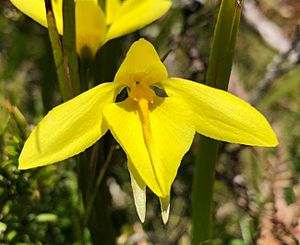Large golden moths facts for kids
Quick facts for kids Large golden moths |
|
|---|---|
 |
|
| Diuris lanceolata in north-west Tasmania | |
| Conservation status | |
| Scientific classification | |
| Genus: |
Diuris
|
| Species: |
lanceolata
|
| Synonyms | |
|
Diuris pedunculata var. lanceolata (Lindl.) Domin |
|
Diuris lanceolata, also known as large golden moths, is a special type of orchid. It is found only in Tasmania, Australia. This means it is endemic to that area.
This beautiful orchid usually has two to four leaves. Its flowers are a lovely golden to orange-yellow color, often with a few dark streaks.
What it Looks Like
The Large golden moth orchid is a plant that grows from a tuber, which is like a small underground storage part. It's a perennial herb, meaning it lives for more than two years and has soft stems.
It has between two and four narrow, long leaves. These leaves are usually about 5 to 18 centimeters (2 to 7 inches) long and 1 to 3 millimeters (0.04 to 0.12 inches) wide.
The plant can have up to three golden-yellow or orange-yellow flowers. These flowers often have a few dark streaks, making them look unique. Each flower is quite wide, about 2.5 to 4 centimeters (1 to 1.6 inches) across. They grow on a stem that stands 6 to 25 centimeters (2.4 to 9.8 inches) tall.
Flower Parts
The top part of the flower, called the dorsal sepal, is shaped like an egg and points upwards. It's about 9 to 17 millimeters (0.35 to 0.67 inches) long. The two side parts, called lateral sepals, hang downwards. They are narrow and pointed, about 15 to 25 millimeters (0.59 to 0.98 inches) long.
The petals of the flower are held out to the sides. They are egg-shaped or spear-shaped, about 10 to 18 millimeters (0.39 to 0.71 inches) long. The labellum, which is the orchid's special lip, is about 14 to 22 millimeters (0.55 to 0.87 inches) long and has three parts, or lobes.
The middle lobe of the labellum is egg-shaped, about 10 to 15 millimeters (0.39 to 0.59 inches) long. The two side lobes stand upright and have uneven edges. You can also see bumpy ridges, called callus ridges, at the base of the labellum. These orchids usually bloom from November to February.
Naming the Orchid
The Large golden moth orchid was first officially described in 1840 by a scientist named John Lindley. He wrote about it in his book The Genera and Species of Orchidaceous Plants.
The second part of its scientific name, lanceolata, comes from a Latin word. It means "spear-like," which describes the shape of some of its flower parts.
Where it Lives
Currently, the Large golden moth orchid is only known to grow in two places in Tasmania. One spot is on the north coast, and the other is on the west coast.
These orchids like to grow in wet grasslands, in areas with low-growing shrubs called heath, and in coastal scrubland.
Protecting the Orchid
The Diuris lanceolata is considered an "endangered" species. This means there are very few of them left, and they are at high risk of disappearing forever.
Both the Australian government and the Tasmanian government have laws to protect this orchid. It is listed as endangered under Australia's Environment Protection and Biodiversity Conservation Act 1999 and Tasmania's Threatened Species Protection Act 1995. These laws help to protect its habitat and ensure its survival.


